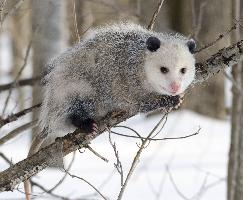
Animal description
The Virginia opossum (Didelphis virginiana), often simply known as the opossum, is a fascinating marsupial native to North America, particularly the United States, Mexico, and Canada. As the only marsupial found north of Mexico, it occupies a unique niche in its ecosystem, serving as a nocturnal scavenger with a wide range and a highly adaptable nature.Physically, the Virginia opossum is a medium-sized mammal, with adults typically measuring about 2 to 3 feet in length, including their tails, and weighing between 4 to 14 pounds. They possess a distinctive appearance with a white or grayish coat, a pointed snout, and sharp teeth. One of their most recognizable features is their prehensile tail, which is capable of grasping and holding objects, though it is a misconception that they hang from trees by their tails for extended periods. Their feet are also notable for having opposable thumbs, which aids in climbing and grasping.
The Virginia opossum has a rather robust and flexible diet, being omnivorous scavengers. They consume a wide variety of foods, including fruits, insects, small rodents, eggs, and even carrion. This dietary flexibility has allowed them to thrive in a wide range of habitats, from wooded areas and farmlands to suburban and urban environments.
One of the most intriguing aspects of the Virginia opossum is its defensive mechanisms. When threatened, it may hiss, growl, and show its teeth to ward off predators. However, it is best known for "playing possum," a behavior where it mimics the appearance and smell of a sick or dead animal. This involuntary reaction causes the opossum to become stiff and unresponsive, deterring many predators who prefer live prey.
Reproduction-wise, the Virginia opossum exhibits typical marsupial reproductive strategies. Females have a short gestation period, after which the tiny, underdeveloped young must make their way into the mother's pouch to continue developing. Inside the pouch, they latch onto a nipple, where they remain for several weeks until they are more fully developed.
Virginia opossums are solitary and nocturnal, primarily active at night when they forage for food. They are also known for their remarkable ability to resist venom from snakes, including rattlesnakes and cottonmouths, making them resistant to bites that would be lethal to other animals.
Despite their adaptability and resilience, Virginia opossums face challenges such as habitat loss, vehicular accidents, and hunting in some areas. However, they are currently not considered endangered and have a stable population, thanks in part to their versatility and broad range.
In summary, the Virginia opossum is a unique and adaptable marsupial with a range of interesting behaviors and characteristics. From its omnivorous diet and defensive behaviors to its reproductive strategies and role in the ecosystem, the Virginia opossum continues to fascinate and thrive in a variety of North American environments.
Similar Animals
New photos of animals
Top 10 animals
- Dolphin gull (Leucophaeus scoresbii)
- Diana monkey (Cercopithecus diana)
- Moustached guenon (Cercopithecus cephus)
- Galápagos tortoise (Geochelone nigra complex)
- Japanese macaque (Macaca fuscata)
- Stone loach (Barbatula barbatula)
- Russian tortoise (Testudo horsfieldii)
- Greek tortoise (Testudo graeca)
- Common flying dragon (Draco volans)
- Vendace (Coregonus albula)
